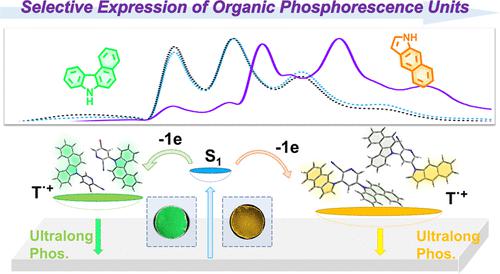当前位置:
X-MOL 学术
›
Chem. Mater.
›
论文详情
Our official English website, www.x-mol.net, welcomes your
feedback! (Note: you will need to create a separate account there.)
Selective Expression of Organic P hosphorescence Units: When H-Benzo[f]indole Meets 7H-Benzo[c]carbazole
Chemistry of Materials ( IF 7.2 ) Pub Date : 2023-03-07 , DOI: 10.1021/acs.chemmater.3c00193 Xue Zhang 1 , Chen Qian 1 , Zhimin Ma 2 , Xiaohua Fu 1 , Zewei Li 2 , Huiwen Jin 1 , Mingxing Chen 2 , Zhiyong Ma 1
Chemistry of Materials ( IF 7.2 ) Pub Date : 2023-03-07 , DOI: 10.1021/acs.chemmater.3c00193 Xue Zhang 1 , Chen Qian 1 , Zhimin Ma 2 , Xiaohua Fu 1 , Zewei Li 2 , Huiwen Jin 1 , Mingxing Chen 2 , Zhiyong Ma 1
Affiliation

|
Phosphorescence selective expression in the development of ultralong organic room-temperature phosphorescence (UORTP) materials to enrich the properties and functions of smart materials is a very interesting topic but has not been realized yet due to the lack of organic phosphorescence units. In this work, we, for the first time, investigate the selective expression phenomenon of two organic phosphorescence units in a single molecule. First, we report a new phosphorescence unit 7H-benzo[c]carbazole (BCz) with the advantage of simple synthesis. BCz derivatives (PNBCz-1 and PNBCz-2) feature photoactivated green ultralong phosphorescence in the PMMA film at room temperature, and cation radicals are involved in the unique ultralong phosphorescence behavior, which is similar to H-benzo[f]indole (Bd) derivatives. Different from Bd, pure powders of BCz derivatives show intense red-shifted ultralong phosphorescence at 77 K, probably due to the extended π conjugated structure of BCz. Then, BCz and Bd were incorporated into a single skeleton and two asymmetric molecules (PNBCzBd-1 and PNBCzBd-2) were obtained. Surprisingly, in the PMMA film, PNBCzBd-1 and PNBCzBd-2 both show photoactivated yellow ultralong phosphorescence at room temperature assigned to the intrinsic phosphorescence emission of Bd, and intrinsic green phosphorescence of BCz is almost screened by Bd. Density functional theory (DFT) calculations reveal that the incorporation of Bd leads to the shifting of the phosphorescence emission centers from BCz units to Bd units. Therefore, the intrinsic phosphorescence emission of Bd is selectively expressed in the case of PNBCzBd-1 and PNBCzBd-2. To our best knowledge, this is the first example that reports the selective expression behavior of organic phosphorescence units. We believe that this study may impact the future research of UORTP materials and lay the foundation for their future applications.
中文翻译:

有机磷光单元的选择性表达:当H-苯并[f]吲哚遇到7H-苯并[c]咔唑时
开发超长有机室温磷光 (UORTP) 材料以丰富智能材料的性能和功能是一个非常有趣的课题,但由于缺乏有机磷光单元,目前尚未实现。在这项工作中,我们首次研究了单个分子中两个有机磷光单元的选择性表达现象。首先,我们报道了一种新的磷光单元 7 H -苯并[c]咔唑 (BCz),具有合成简单的优点。BCz衍生物(PNBCz-1和PNBCz-2)在室温下在PMMA薄膜中具有光激活的绿色超长磷光,阳离子自由基参与了独特的超长磷光行为,类似于H-苯并 [f] 吲哚 (Bd) 衍生物。与 Bd 不同,BCz 衍生物的纯粉末在 77 K 时显示出强烈的红移超长磷光,这可能是由于 BCz 的扩展 π 共轭结构。然后,将 BCz 和 Bd 结合到一个骨架中,得到两个不对称分子(PNBCzBd-1 和 PNBCzBd-2)。令人惊讶的是,在 PMMA 薄膜中,PNBCzBd-1 和 PNBCzBd-2 在室温下都显示出光激活的黄色超长磷光,归因于 Bd 的本征磷光发射,而 BCz 的本征绿色磷光几乎被 Bd 屏蔽。密度泛函理论 (DFT) 计算表明,Bd 的掺入导致磷光发射中心从 BCz 单位转移到 Bd 单位。所以,Bd 的本征磷光发射在 PNBCzBd-1 和 PNBCzBd-2 的情况下被选择性地表达。据我们所知,这是第一个报告有机磷光单元选择性表达行为的例子。我们相信这项研究可能会影响未来UORTP材料的研究,并为其未来的应用奠定基础。
更新日期:2023-03-07
中文翻译:

有机磷光单元的选择性表达:当H-苯并[f]吲哚遇到7H-苯并[c]咔唑时
开发超长有机室温磷光 (UORTP) 材料以丰富智能材料的性能和功能是一个非常有趣的课题,但由于缺乏有机磷光单元,目前尚未实现。在这项工作中,我们首次研究了单个分子中两个有机磷光单元的选择性表达现象。首先,我们报道了一种新的磷光单元 7 H -苯并[c]咔唑 (BCz),具有合成简单的优点。BCz衍生物(PNBCz-1和PNBCz-2)在室温下在PMMA薄膜中具有光激活的绿色超长磷光,阳离子自由基参与了独特的超长磷光行为,类似于H-苯并 [f] 吲哚 (Bd) 衍生物。与 Bd 不同,BCz 衍生物的纯粉末在 77 K 时显示出强烈的红移超长磷光,这可能是由于 BCz 的扩展 π 共轭结构。然后,将 BCz 和 Bd 结合到一个骨架中,得到两个不对称分子(PNBCzBd-1 和 PNBCzBd-2)。令人惊讶的是,在 PMMA 薄膜中,PNBCzBd-1 和 PNBCzBd-2 在室温下都显示出光激活的黄色超长磷光,归因于 Bd 的本征磷光发射,而 BCz 的本征绿色磷光几乎被 Bd 屏蔽。密度泛函理论 (DFT) 计算表明,Bd 的掺入导致磷光发射中心从 BCz 单位转移到 Bd 单位。所以,Bd 的本征磷光发射在 PNBCzBd-1 和 PNBCzBd-2 的情况下被选择性地表达。据我们所知,这是第一个报告有机磷光单元选择性表达行为的例子。我们相信这项研究可能会影响未来UORTP材料的研究,并为其未来的应用奠定基础。






























 京公网安备 11010802027423号
京公网安备 11010802027423号